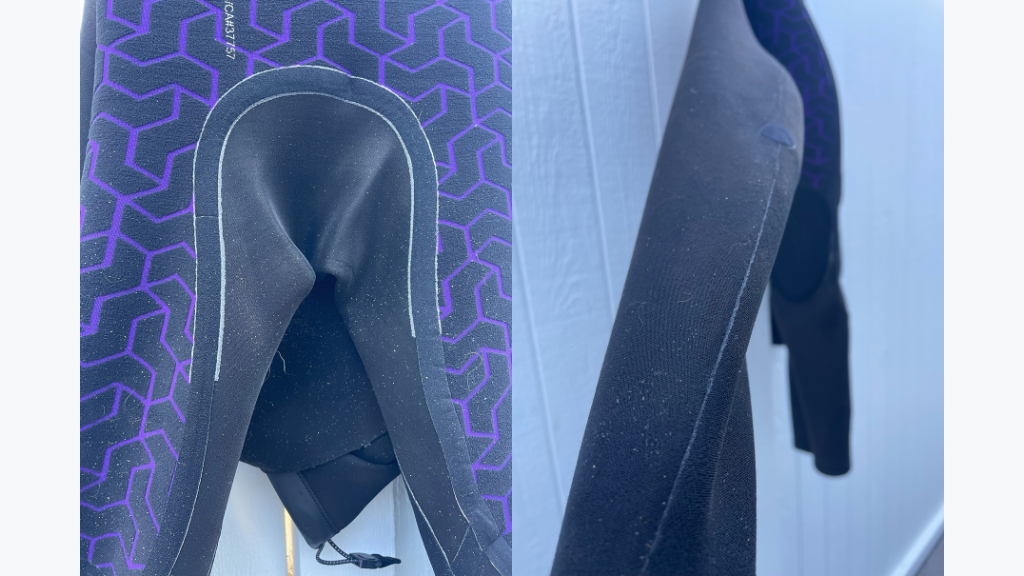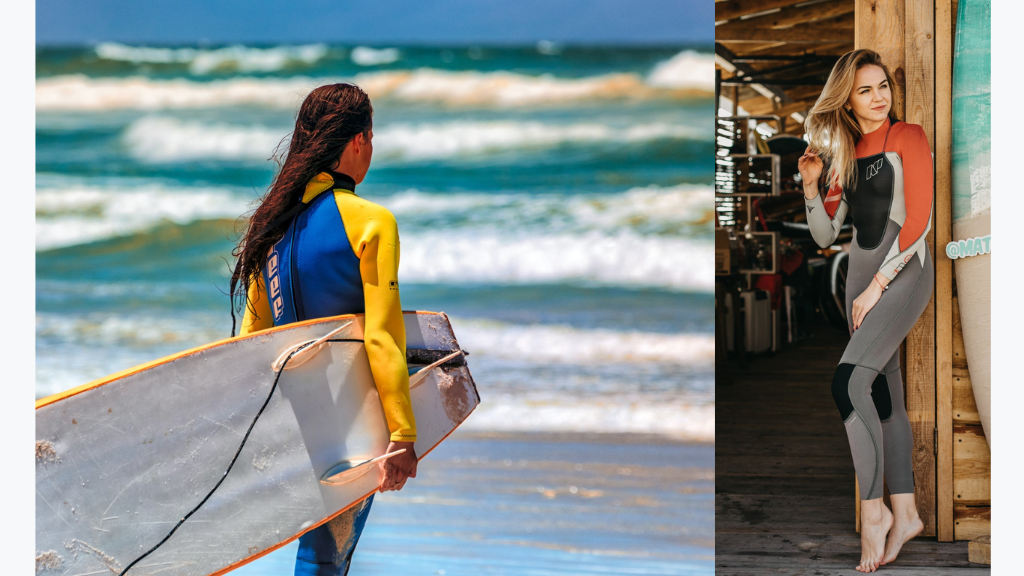For your sake and mine, let’s dive in on how to stop both wetsuit chafing and surfer’s rash—whether it’s on your neck, armpits, thighs, or behind your knees.
14 Ways to Stop Wetsuit Chafing and Surfer’s Rash
1. Rule out other irritations
Most likely, irritation from wearing a wetsuit is chafing. But other reasons for irritation include:
- Neoprene allergy
- Swimmer’s itch
- Skin rash from cyanobacteria
If you’re one of the unlucky few with a neoprene allergy, check out this post from Wetsuit Wearhouse about hypoallergenic wetsuits.
2. Surf more and toughen your skin
I’ve been chafed while surfing in rash guards and wetsuits more times than I care to admit. New boards and new wetsuits sometimes trigger it if I don’t take precautions. So while I can’t say my skin ever felt like it “toughened up”, lots of surfers swear it happens.
If your new wetsuit is chafing you, and for some reason you don’t want to lube up, let your wound heal and then keep surfing. Apparently for some people, calluses will develop and that chafing will go away.
3. Throw on a base layer
Compression shorts, leggings, and rash guards give you an extra layer of protection against both wetsuit chafing and surfer’s rash. Just make sure your base layer doesn’t have any zippers or overlock seams, both of which can cause chafing. Instead, find a base layer that only uses flat-locked seams.
A flatlock seam is a stitching method that places two pieces of fabric side by side, so that the edges touch but don’t overlap, and stitches them together. The result is a flat seam. An overlock seam places the two pieces of fabric one on top of the other and stitches along the edge, so that the seam sticks out a little.
4. Check your wetsuit or rashguard seams
Speaking of seams, your wetsuit or rashguard also has them. If part of the seam is sticking out or loose, that could be the cause of your chafing. So check out the inside of your suit and look for any irregularities in your seams.

It’s also worth looking to see what kind of seams your wetsuit has. More affordable wetsuits meant for warm water use flatlock seams, but these can cause chafing. Wetsuits with sealed or liquid-taped seams are an alternative that leave you less susceptible to chafing.
5. Get the right size (and quality) of wetsuit to prevent chafing
According to Cleanline Surf, your wetsuit should fit snugly, but not so tight that your range of motion is limited. Full-length sleeves should fall at the wrist and legs just above the ankle. There should be no gaps, pockets, or rolls of neoprene. Gaps, pockets, or rolls are excess material which can be a source of chafing.

If you’re buying your first new wetsuit, find your preferred brand’s sizing chart, since they vary. Here’s one from Billabong and one from Xcel.
If you’re getting a used wetsuit or renting one, just be aware that degraded neoprene in worn wetsuits can be irritating. Usually the quality of the material in a new wetsuit will be fine.
6. Get a wetsuit specific to surfing
Swimming wetsuits are different from diving wetsuits are different from surfing wetsuits. For instance, diving wetsuits are much less flexible than surfing wetsuits, which are designed for performance.

Whether you’re surfing, diving, or swimming, avoid using a wetsuit that wasn’t designed for your sport.
7. Lube up with a non-petroleum-based lubricant
Lubricant forms a thin layer between your skin and the neoprene of your wetsuit (or your rashguard), which prevents any rubbing on the areas where you apply the lubricant. The only trouble is, lots of lubricants are petroleum-based, which erodes neoprene. So you want to avoid vaseline and opt for non-petroleum-based lubricants like:
(I’ve used both of these to great effect.)
8. Rinse your wetsuit or rash guard after surfing and clean it periodically
If they’re not washed away, sand, salt, and dirt inevitably get embedded into your wetsuit. Let it build up and you’ll be a lot more likely to experience chafing.
To avoid buildup, after each surf, rinse your wetsuit inside and out. Hang the wetsuit away from direct sunlight (UV rays break down neoprene) and let it drip dry.
Every once in a while, it’s a good idea to give your wetsuit a soapy bath. Just make sure you use a wetsuit shampoo like Gear Aid Wetsuit Cleaner and Conditioner.
With rashguards, a run in the washing machine will suffice.
9. Use a wetsuit mat
Changing into or out of your wetsuit on sand, gravel, dirty tarmac, or asphalt will embed irritating debris into your wetsuit. On top of making chafing more likely, this debris will also reduce the lifespan of your wetsuit.
So grab a wetsuit mat and tuck it into your backpack or car next time you decide to paddle out.
10. Don’t hang out in your wetsuit
I understand if you’re too exhausted to pull off your wetsuit right after your surf. But if you want to avoid the dreaded surfer’s rash, don’t linger in your wetsuit. They’re not designed for lots of walking, running, or even lounging around. Plus you’re more likely to pick up debris that causes chafing.
11. When your sans wetsuit, skip the wax comb
Wax combs help add traction without globbing on more wax. But it also makes the surfboard much rougher and less forgiving. If you’re not wearing a wetsuit, which provides more padding than a rashguard, this roughness could cause surfer’s rash.
12. If you feel it coming, don’t tough it out
If you’ve chafed as much as I have, you can probably feel when it’s starting to happen. But if you’re like me, you won’t want to get out of the water. And the chafing will just get worse and worse. But you should do as I say and not as I do and get out of the water if you’re starting to chafe. Then throw on some body glide or get a better wetsuit and get back out there.
13. Lose weight
According to Dr. Nick Olmos-Lau, “Below the dermis sits a layer of fat. If the skin is well-padded or the fat layer is thick, the skin protrudes. This exposes more skin to friction and produces more severe “burns”. In other words, more slender people report that they are less likely to abrade.”
14. Take extra precautions in saltier water
The world’s oceans have varying levels of saltiness (or salinity). And more salty water is more likely to cause wetsuit chafing or surfer’s rash.
According to LiveScience there is, “Higher salinity in the subtropics, higher average salinity in the Atlantic compared with the Pacific and Indian oceans, and lower salinity in rainy belts near the equator, the northernmost Pacific Ocean and elsewhere.
15. Keep your surfboard wax clean
Dirt and sand inevitably build up in your surfboard’s wax. This additional material creates more potential for friction. To avoid this, strip the wax on your board and replace it every few months, depending on how much you surf.
You just need a wax comb and a Pickle Wax Remover to get your wax off. This Pickle Wax Remover with Sticky Bumps Comb kit will do the trick.
FAQs: How to Stop Surf Rash
A good pair of leggings or compression shorts can help stop your thighs from chafing when you’re surfing. Just make sure you turn the leggings inside out and check them for any rough seams that might irritate your skin before you start wearing them.
Low-quality, ill-fitting, or worn-out wetsuits can cause chafing. You can use a non-petroleum based lubricant, like BodyGlide, to prevent chafing even with a suboptimal wetsuit.
Don’t use Vaseline to prevent neck chafing from your wetsuit. Vaseline is petroleum-based and will damage your wetsuit. Instead, use a non-petroleum-based lubricant like BodyGlide.
The Root Cause of Chafing
The Cleveland Clinic says chafing occurs when you have “Repeated skin-on-skin contact or when your skin rubs against clothing or another material. Common causes include intense exercise, ill-fitting clothes, excess skin and hot weather. Prevention includes wearing appropriate clothing and using anti-chafing products or petroleum jelly.”
Wetsuit chafing is usually caused by the neoprene of your wetsuit rubbing against your skin. The trouble is, petroleum products can break your wetsuit down quicker, so you want to find a non-petroleum lubricant like Body Glide. But we can forgive The Cleveland Clinic for their lack of surf-specific advice.
Surfer’s rash is caused by the rough surface of your board rubbing against your skin. And the key preventive measure there is wearing appropriate clothing.
